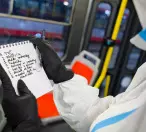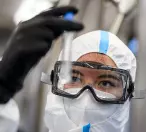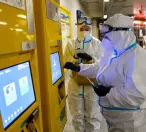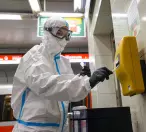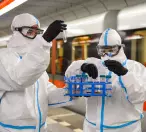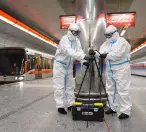The Safety of Prague’s Public Transportation System is Confirmed by a Study Completed by the Czech Academy of Sciences – the System is Not a Source of Covid 19 Infections
10. 06. 2021
Prague, 10 June 2021 – Recently, large-scale testing of Prague‘s public transportation system for signs of Covid-19 transmissibility was initiated by the Prague Public Transit Company (DPP). The extensive testing of the system, which was carried out in April 2021 by researchers from the Institute of Physics of the Czech Academy of Sciences (AVČR), found no evidence of the infectious presence of the SARS-CoV-2 virus. The analysis included the testing of a total of 558 samples taken from buses, trams, train sets, platforms and Metro vestibules. These tests confirmed the conviction that Prague‘s public transport system was a safe environment for its passengers and that the system was, and is not a source of Covid-19 infection transmissibility when basic precautions and proper hygiene rules are followed.
The research, in which scientists from the Biological Center of the AVČR and the Faculty of Science of the University of South Bohemia also collaborated, was the first of its kind to be conducted in the Czech Republic. A total of 588 environmental surface and air samples were taken to detect the presence of the SARS-CoV-2 virus. The researchers obtained 154 samples from bus interiors, 160 from trams, 126 from train sets and 52 from Metro platforms and vestibules. Using specialized equipment designed to measure air quality, another 66 samples were taken from the interiors of vehicles and Metro stations. The samples were all taken in early April 2021, a period in which the Covid-19 pandemic was at a peak in the Czech Republic. Surfaces were tested when vehicles had either returned to a depot or when they were at a turnaround point – that is, before cleaning and after being full of passengers. Unlike the surface testing, air testing was done with passengers present.
The inspiration for this Covid research was similar studies carried out last autumn and again this spring by Transport for London. However, the tests conducted by DPP and the Czech Academy of Sciences were more extensive, with a larger number of samples taken. They also took samples from all of the primary different modes of public transport, unlike in London, which focused on the underground.
100% of Samples Were Non - Infectious
Each sample taken was first analyzed using A-QCM biosensors, specially modified by scientists from the Institute of Physics of the AVČR, to detect the presence of disease pathogens on surfaces. Subsequently, each sample was taken to the laboratories of the Faculty of Science of the University of South Bohemia in České Budějovice for examination using the standard qRT-PCR test. The first procedure works to detect the presence of the viral protein. The PCR test then captures the genetic information of the virus.
Out of the total of 558 samples, only 6 (i.e. roughly 1%) showed any detectable presence of viral material. The biological viral samples were then taken to the laboratories of the Faculty of Science where they were cultivated and tested for infectivity at intervals of 3, 6 and 9 days using the above-noted standard qRT-PCR test method. These subsequent tests showed, in each case, at each of the different timing intervals, that the viral particulate matter found was inanimate and non-infectious.
“Using the combination of the PCR tests, the new biosensors and the subsequent cultivation of suspicious samples allowed us to get a good, representative overall picture of the presence and infectivity or, in this case, the non-infectivity of the virus in public transport. The results of the study gave us clear evidence that there was no danger of virus transmission to passengers in Prague's public transportation system, provided other basic hygiene rules were observed,” stated Alexandr Dejneka, Analysis Coordinator from the Institute of Physics of the AVČR.
“The great news is that we know Prague's public transport system is safe. It is not, and was not, a source of Covid-19 infection transmission, even at a time when the pandemic was at a peak. This has now been confirmed by the results of the study just completed by the Czech Academy of Sciences and DPP. Early on, we realized that maximizing the introduction of fresh air in our transport ventilation systems would be beneficial and it turns out, we and DPP must have been right. An increase in the frequency of vehicle cleaning, the use of higher concentrations of cleaning and disinfection agents throughout the period of the pandemic has also certainly helped as well. These added expenditures were made even though system revenues were declining. We have now clearly shown that concerns about the health risks from the use of public transport are wrong. In addition, I am pleased to note that, thanks to the initiative shown by DPP in sponsoring this research project, we now have good information to benefit other transport companies in the Czech Republic. This research provides another example of why Prague's public transportation system has long been rated as one of the best in the world,” added Adam Scheinherr, Deputy Mayor for Transport and Chairman of the Supervisory Board of DPP.
“Research conducted by scientists from the Czech Academy of Sciences has now confirmed several important things. First of all, Prague's public transportation system is not, and has not been, a source of spread of the Covid-19 infection, as some professionals in the Czech Republic have recently alleged and hypothesized. This isn’t new or surprising information as it has been confirmed by similar studies conducted in other countries. Secondly, there was absolutely no transmissible trace of the Covid-19 virus detected in the air inside of the tested vehicles. Each air sample was taken for a full 30-minute period, which is a rough approximation of the average time passengers spend in a Prague public transportation vehicle. The measures we have put in place to combat the pandemic, such as more intensive and more frequent cleaning of vehicles and improvements to vehicle ventilation systems, are proving to have worked as shown by the positive results from this recent study. We have set a new standard for public transport hygiene which we expect to continue. But we note that while the system’s cleanliness standards have been raised, they are only as good as the basic standards of hygiene adhered to by passengers. We all need to work together to maintain a healthy and safe environment for passengers on Prague's public transportation system,” concluded Petr Witowski, Chairman of the Board of Directors and CEO of DPP – adding, “we also want to extend our thanks to colleagues from Transport for London for their invaluable cooperation in helping us connect our scientists from the Institute of Physics of the AVČR with their experts from Imperial College London.”
Biosensor Testing
Testing for the presence of the SARS-CoV-2 virus using our special type of biosensors is a new method for detecting the presence of pathogens on surfaces, which researchers at the Institute of Physics of the AVČR have been working on since last year. "The advantages of the biosensors include the speed with which they can detect the presence of the virus and the fact that the sample does not require special preparation, it need only be placed in a special solution," commented Hana Lísalová from the Institute of Physics of the AVČR, the developer of the new technology. "Both the PCR and the biosensor showed similar sensitivity to the presence of the virus, and therefore reliability, in terms of the testing we did on Prague’s transport systems, which was great news for the scientific team," Hana Lísalová added.
Where the Samples Were Collected
For the surface samples taken, DPP deliberately chose Metro lines and stations that were in close proximity to major Prague hospitals, clinics and medical facilities.
For buses, the surface samples were taken on Lines 124, 139, 150, 188, 199 and 213 at the Želivského turning loop. In each vehicle, there were up to 11 selected places that passengers most often touch that were tested. These include locations such as the door open buttons, ticket markers, door handles and vertical and horizontal grab bars, seat handles, the horizontal bar at the designated place for strollers, seat upholstery and the Stop button. The researchers swabbed a total of 154 places on these buses.
Trams were sampled at the Březiněveská Loop on Lines 3 and 24. Researchers selected 12 locations in each vehicle, similar to where samples were taken on buses. In addition, there were ticket validation touch screens, door handles and the vertical grab bars at the juncture points of articulated trams. Researchers collected a total of 160 samples from trams.
For the Metro, researchers took samples from train sets at the Hostivař Depot, from which DPP operates Line A, and at the Kačerov Depot, which serves Line C. Similar to how the surface transport vehicles were sampled, they focused on door opening buttons, handles on Plexiglas panels and horizontal and vertical grab bars in the middle of cars. They collected a total of 126 samples. The researchers took another 52 surface samples on the platforms and vestibules of the Budějovická, Palmovka and Želivského stations. These came from the escalator handles, stair railings, touch screens of ticket machines, benches, elevator call buttons, etc.
Air quality sampling took place in the same Metro stations, always on both the platform and in the station vestibules, in train sets on the route Ládví - Háje - Florenc, Florenc - Zličín - Můstek, Můstek - Motol Hospital - Museum, Museum - Háje - Florenc and Florenc - Černý Most - Florenc. In trams, air was sampled on Lines 1, 2, 3, 9, 10, 11, 16, 18 and on Bus Lines 125, 167, 177, 188, 193 and 196. One sample was taken in each location for a period of a full 30 minutes. A total of 66 samples were taken. The air sampling device, which is based on a specially designed polymer nanobrush, was developed in collaboration with physicists from the National Center of Competence – MATCA.
Contacts for more information:
E-mail: tiskoveoddeleni@dpp.cz




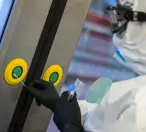
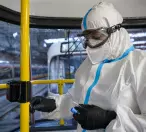 Show photo gallery (14)
Show photo gallery (14)